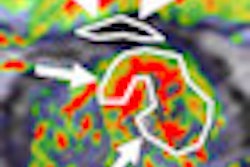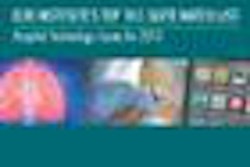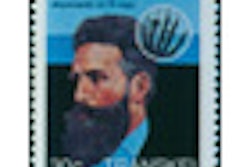
VIENNA - Legal and regulatory issues surrounding the production and uses of radiotracers represent a significant threat to PET imaging, a senior luminary told ECR 2013 attendees at Sunday's professional challenges session on the legal matters related to multimodality techniques.
Speaking emphatically on the issue, Dr. Gustav von Schulthess, PhD, from the department of medical radiology, nuclear medicine at Zurich University Hospital, explained his frustration with the current situation.
 Dr. Gustav von Schulthess from Zurich. Image courtesy of the European Society of Radiology.
Dr. Gustav von Schulthess from Zurich. Image courtesy of the European Society of Radiology.
"Tracer regulations have become so painful and so costly that university investigators and companies alike are deterred [from development]," he remarked. "A radiotracer costs a lot to produce, and this is mainly to do with the regulations. The world hasn't come to grips with this."
He added that the most exciting activity in imaging modalities right now was the development of new tracers. "These will open possibilities of totally novel examinations, because each new tracer generates a new imaging modality. If you look at glucose metabolism, then you see aggressive tumor growth; if you do Alzheimer's plaque imaging, you see something different, so tracers are key to this."
In contrast to all the excitement about potential new tracers in the era of personalized medicine, he said that if regulations around the world relating to new tracers become too complicated, that would hamper and extend the time to development.
"Tracers are considered to be drugs by the regulator, but are used in very low quantities," von Schulthess explained. "If you use tracers at high dose, then they are dangerous -- so thallium was used for myocardial imaging at very low doses, but at stardard doses it is rat poison. We inject it at 1/50,000ths of the lethal dose, so it has no impact, but somehow the regulation agencies have a hard time distinguishing between use of a drug as a therapeutic agent and use as a tracer."
He believes regulations with respect to tracers are important, but they come from the wrong corner -- i.e., the drug corner. He cited the example of iodinated contrast agent for x-rays or MR contrast agents, which when injected, are injected at pharmacologically active doses and therefore have to be made such that they leave the body immediately, pointing out that these safety regulations were good. "But in nuclear medicine, it's different. We can treat patients with thyroid disease with radioactive iodine even if they have an iodine allergy; we can still use it because the dose is so low that it has no physiological effect," he said.
He explained that the exquisite sensitivity of the tracers meant a tracer could be injected at a very low dose for the receptor systems and molecular interactions to be visible.
Von Schulthess then touched upon the many legal issues around production. He said that an application for a tracer marketing authorization required preclinical and clinical data, including toxicity, good manufacturing practice (GMP) production, and other safety tests. Basically, authorities consider PET tracers to be a drug, so you have to do everything you would for a drug approval, he said.
"It is now such that in order to introduce a new tracer just for research, we have to do a toxicity study, which at the newly required level cost us 100,000 CHF" (Swiss francs, approximately 81,000 euros), he said. "So even to think of producing a new radiolabelled tracer for experiments we have to spend 100,000 CHF."
At Zurich, several PET tracers are produced. Recently, they have gotten approval for fluorine-labeled choline (F-choline), and so the hospital is the only legal provider of F-choline in Switzerland, but to get to this point a cost between 500,000 and 1 million Swiss francs was accrued, which is a major cost issue, he explained.
Adding further frustration, von Schulthess explained that reimbursement for a tracer is a separate step and does not automatically follow from approval.
Understandably, companies are reluctant to invest under these circumstances, because it increases the cost of getting a tracer on the market. Many of these tracers are orphan applications due to the small number of potential patients. Alzheimer's disease is an exception to this with maybe a market of 30,000 patients in a country the size of Switzerland (8 million), but this has to be compared with 200 to 500 patients with neuroendocrine tumors for which a researcher might need to use a tracer such as gallium-68 DOTATATE.
 Alan Perkins, PhD, from Nottingham, U.K. Image courtesy of the European Society of Radiology.
Alan Perkins, PhD, from Nottingham, U.K. Image courtesy of the European Society of Radiology.
Presenting in the same session was Alan Perkins, PhD, a professor of medical physics from the University of Nottingham, U.K. He discussed radiation protection frameworks at regional, national, and international levels, and the responsibilities and training of different personnel in the working environment. He thinks the single issue that stands out as needing particular attention is staff training.
"They need to be qualified in all the areas they are working in. This is a real challenge in the hospital environment, because there are often turf wars involved, professional differences between physicians and radiologists, as well as fees and money, which all cause conflict," he commented. "Radiographers and technicians need to be fully trained in the relevant modalities."
In the U.K., a hospital's radiation safety committee produces a set of policies and approaches. It identifies individuals with responsibility for safety programs, although the nuclear medicine physician has overall clinical responsibility.
Among the other staff in the department, Perkins highlighted radiographers and technicians who need to be dual-trained in all modalities concerned, whether PET, SPECT, or MRI. "They need appropriate training in these environments. There is also a legal requirement for a medical physics expert," he concluded.
Originally published in ECR Today on 11 March 2013.
Copyright © 2013 European Society of Radiology




















